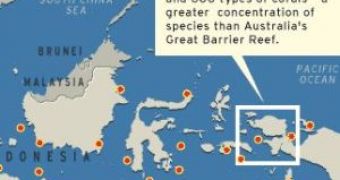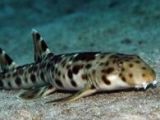At an intensive research of undersea fauna at the legendary Bird's Head Seascape (off North Western Papua New Guinea province of Indonesia) earlier this year, scientists discovered dozens of new species.
Bird's Head Seascape covers 18 million hectares, including 2,500 islands and submerged reefs.
Dubbed Asia's "Coral Triangle", it is home to more than 1,200 species of fish and almost 600 species of reef-building coral, or 75 percent of the world's known total.
Australia's Great Barrier Reef, covering an area 10 times bigger, has more types of fish - 1,464 species - but just 405 species of coral. And the bigger Caribbean Sea has fewer than 1,000 species of fish and just 58 types of coral.
The seascape also includes the largest Pacific leatherback turtle nesting area in the world, and migratory populations of sperm whales, Bryde's whales, killer whales and several dolphin species.
The surveys took place in waters surrounding Papua from Teluk Cenderawasih in the north to Raja Ampat archipelago off the western coast and southeast to the FakFak-Kaimana coastline.
"It's one of the most stunningly beautiful landscapes and seascapes on the planet. Above and below water, it's simply mind blowing" said Mark Erdmann, a senior adviser of Conservation International who led two surveys in the area. Erdmann and his team have discovered 52 new species - including 24 new species of fish - 20 new species of coral and eight new species of shrimp.
Among the highlights were an epaulets shark (photo) that "walks" on its fins, a praying mantis-like shrimp and scores of reef-building corals of all shapes and sizes, he said.
"Six of our survey sites, which are areas the size of two football fields, had over 250 species of reef-building coral each - that's more than four times the number of coral species of the entire Caribbean Sea," he added.
Conservation International said papers on two of the new fish species, called flasher wrasse - because of the bright colors the male exhibits during mating -, have been accepted for publication to the Aqua, Journal of Ichthyology and Aquatic Biology.
Two of the new species are members of the epaulets shark family, which distinguishes itself by sometimes using its fins to scamper away. Their name comes from the fact that they have two large round spots near their heads that look like epaulets.
Carden Wallace, a coral expert and principal scientist at the Museum of Tropical Queensland in Townsville, Australia, said she was not surprised by the finding "mostly because it is a remote location and hasn't been visited by scientists very much."
The finds "will give us a better understanding of where all this diversity originates from and how vulnerable it may be," Wallace said.
But the region's biodiversity faces threats from subsistence fishermen who use dynamite and cyanide, as well as a government plan to introduce commercial fishing along the coast.
Though human population density in the region is low, the coastal people of the Bird's Head peninsula are heavily dependent on the sea for their livelihoods, which now are under threat from a plan to transfer fishing pressures from Indonesia's over-fished western seas to the east toward Papua province.
That has prompted Conservation International to call for the government to set up a series of marine parks around Bird's Head Seascape.
"These Papuan reefs are literally species factories that require special attention to protect them from unsustainable fisheries and other threats so they can continue to benefit their local owners and the global community," Erdmann said.
Deforestation and mining degrade coastal waters. This adds to the requirement to take immediate steps to protect the unique marine life that sustains local communities.
The seascape's central location in the Coral Triangle of the Pacific, which exports and maintains biodiversity in the entire Indo-Pacific marine realm, makes it one of the planet's most urgent marine conservation priorities.
"The coastal villages we surveyed were mostly engaged in subsistence fishing, farming and gathering, and they require healthy marine ecosystems to survive," said Paulus Boli, a State University of Papua researcher who led the socioeconomic component of the expeditions.
"We are very concerned about the potential impact of planned commercial fisheries expansion in the region, and we urge a precautionary approach that emphasizes sustainability over intensive exploitation."
Erdmann said only 11 percent of the area is currently protected, most of it in the Teluk Cendarawasih National Park. He said the government is studying the idea of creating additional marine parks, most of them in the Teluk Cenderawasih National Park area that is supported by the World Wide Fund for Nature-Indonesia (WWF-Indonesia).
Results of the CI-led surveys highlight the need for a well-managed network of multiple-use Marine Protected Areas (MPAs) to conserve the seascape's biodiversity and ensure the long-term sustainability of commercial and subsistence fishing.
The two survey sites are a few hundred miles from another Conservation International site in the Foja Mountains.
In February, researchers announced a survey of the Foja Mountains discovered 20 frog species - including a microhylid frog less than a half-inch long - four new butterfly species, and at least five new types of palms. Foja Mountains are known as a virtual "Lost World" of new species of birds, butterflies, frogs and other wildlife.
"We're thankful to the Ministry of Forestry and CI for the significant data from these surveys, and we are excited to be planning further surveys in 2007 to fill in remaining data gaps that will help us plan the most effective management possible for this exceedingly crucial area," said Dr. Suharsono, head of LIPI's Oceanography Center.
Photo credit: Conservation International, Gerry Allen Map credit: ASEAN Regional Centre for Biodiversity Conservation, U.N. Food and Agriculture Organization

 14 DAY TRIAL //
14 DAY TRIAL // 
